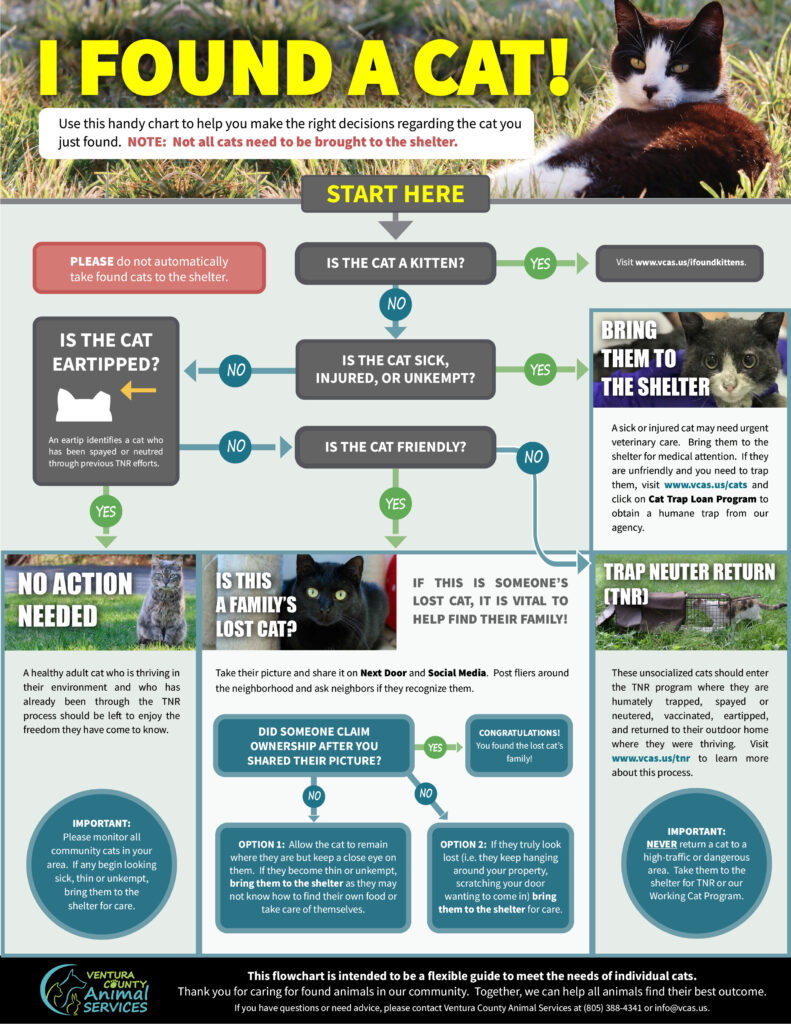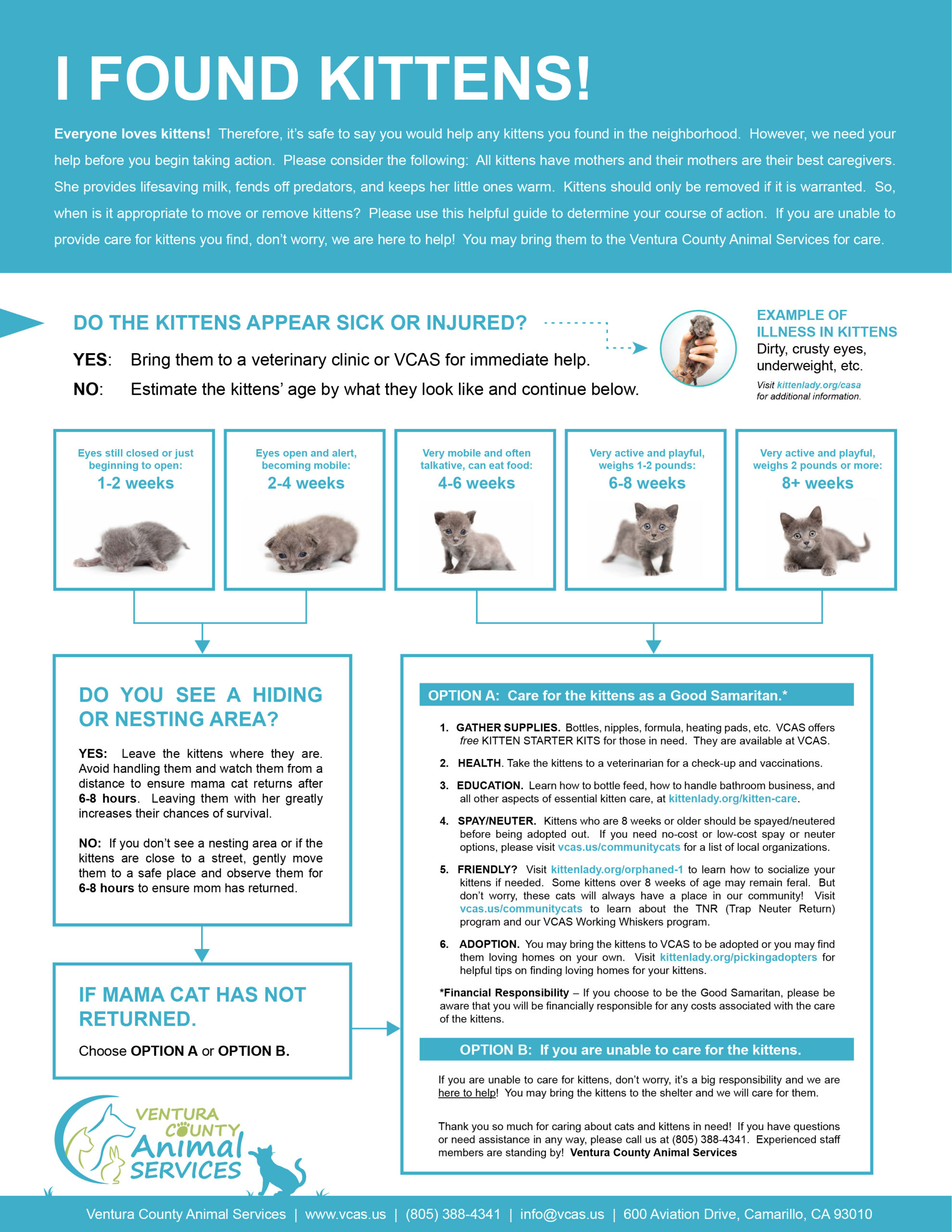CAT PROGRAMS AND RESOURCES
There is a very large population of owned and unowned cats in Ventura County. According to the University of Wisconsin’s Outdoor Cat Population Calculator, based on the size and human population of Ventura County (not including Santa Paula or Thousand Oaks) there are approximately:
- 1,052,017 Indoor only cats
- 701,345 Indoor/outdoor cats
- 1,001,921 Outdoor community cats
Community cats are cats who can be described as outdoor, unowned or free-roaming. They can be friendly or feral, adult or kitten, healthy or sick, altered (spayed or neutered) or unaltered. Community cats may or may not have a caregiver and range in temperament from domestic house cats who have outdoor access, to feral (or wild) cats who cannot be handled.
Feral cats (also known as wild cats) have very little to no human contact. They tend to be fearful of people and survive outdoors alone or in packs. Feral cats are not likely to become domestic unless they are young enough to be domesticated by humans.
Feral kittens are similar to feral cats. The main difference is that some of these kittens can be made to accept human touch over time and even seek affection. If successfully domesticated, these cats can be adopted out. Once kittens have reached a certain age, however, they generally cannot be domesticated.
Ventura County Animal Services has implemented an array of programs and forged crucial partnerships in an effort to find appropriate placements for all cats. It is our responsibility as a community to know what is the best pathway for cats of all temperaments. This page provides expert advice and guidance regarding the appropriate handling of cats of various ages who live in a variety of circumstances. Information provided here is drawn from scientific data collected from well-respected subject matter experts in the field of animal welfare.
Some of our efforts to address the issue of Community Cat include:
- Revised our TNR process to be more user-friendly,
- Providing a single-day TNR surgery process,
- Implemented online surgery appointment scheduling,
- Providing approximately twenty (20) TNR surgeries per week to cats brought in by community members or local trappers,
- Facilitated meetings with members of the Community Cats Coalition, other providers, and key trappers to establish a Community Cat Task Group dedicated to strategically addressing community cat issues,
- Hired a full-time Foster Care Coordinator who helps find temporary placements for thousands of underage/underweight kittens annually,
- Established a Feline Care Coordinator position dedicated to overseeing the care and pathways for cats of all temperaments within the shelter,
- Hosted and facilitated a Community Information Event with Christi Metropole from the Stray Cat Alliance in Los Angeles,
- Hosted and facilitated a Community Information Event with Dr. Kate Hurley, director of the Koret Shelter Medicine Program at USC,
- Updated our website to provide clear and comprehensive information regarding cat/kitten services and resources,
- Received funding from the California Department of Food and Agriculture (CDFA) to provide spay/neuter surgical services to 100 unowned community cats,
- Received funding from the California Department of Food and Agriculture (CDFA) for our “Going Home with a Cone” program designed to provide crucial spay/neuter services for animals redeemed by pet owners who are low-income,
- Implemented a Cat Trap Loan Program to provide humane traps to those who wish to trap cats for the purposes of TNR,
- Partnered with the Simi Valley Non-Profit Spay & Neuter Clinic to provide no-cost spay/neuter services to the residents of contract cities via their mobile clinics,
- Provide spay/neuter vouchers for pet owners,
- Updated our lost and found page to include specific information for cat parents on how to increase their chances of finding their lost cat,
- Created no-cost KITTEN STARTER KITS for Good Samaritans who would like to care for underage/underweight kittens they have found.
I FOUND A CAT
Generally speaking, if you found an adult cat in the community who appears healthy, in good condition, and are of a healthy weight, they’re likely being cared for by someone nearby and should not be taken to the shelter. Why? Approximately 65% of outdoor cats are being taken care of by someone nearby, and about 66% of cats who are reported as “missing” actually return home on their own if left undisturbed.
Automatically taking these cats to the shelter doesn’t really help them find their families because only about 6% of stray cats brought to the shelter are ever reunited with their families or caregivers. Why? Unlike dog owners, cat owners tend to wait longer to see if their cat returns home. And after their 5-day stray hold has ended in our shelter, they are made available for adoption. Cats placed in kennels causes their stress level to rise which lowers their immune system making them susceptible to illness. This is why it is crucial to leave healthy and happy cats where they are.
If a cat appears sick or injured, if their coat appears unkempt, if they appear to be thin, please bring them to the shelter for care. Please note that only 6% of stray cats brought to shelters are ever reunited with their families. Please use this handy chart to help you make decisions about the cat you just found.
WHAT TO DO IF YOU FOUND AN ADULT CAT
I FOUND KITTENS
Before you bring kittens to the shelter, please consider the following. All kittens have mothers, and their mothers are their best caregivers. She provides lifesaving milk, fends off predators, and keeps her little ones warm. Kittens should only be removed in the following scenarios:
- If the kittens appear sick or injured. Carefully transport them to a local veterinarian or bring them to VCAS for care.
- If kittens are located in a dangerous place (i.e., near a busy street). Gently move them, along with their nesting area if they have one, to a safer place nearby so their mother can easily find them. Keep an eye on them to make sure mama cat returns.
- If mama cat does not return. If mama cat has not returned from hunting within 6-8 hours, you can either care for her kittens on your own as a their caretaker, or you can bring them to VCAS to be placed into our Foster Care program. To give you a jump start on your kitten journey, we have created KITTEN STARTER KITS available at no cost should you wish to be a part of the community cat solution.
- If kittens are older than 4 weeks. Kittens older than four (4) weeks are now old enough to eat solid food and will benefit from human socialization. They should then be adopted out to a loving family. As a Good Samaritan, you can either find the kittens good homes on your own, or you can contact VCAS for assistance. Visit www.kittenlady.org/pickingadopters for helpful tips on finding loving homes for kittens. Kittens who are eight (8) weeks or older should be spayed/neutered before being adopted out. Scroll down to view a list of local organizations who may be able to provide no-cost or low-cost spay/neuter services. Visit www.kittenlady.org/feral?rq=feral kittens for helpful tips on how to socialize your kittens.
- Some kittens (older than 8 weeks), may not easily become socialized and could remain feral. But don’t worry as these cats will always have a place in our community, either through our county’s TNR program, or our shelter’s Working Whiskers program.
HUMANE TRAPPING
Ventura County Animal Services is proud to be a part of a countywide TNR effort to help control the overpopulation of community cats. TNR stands for “Trap Neuter Return”, a process whereby feral/community cats are humanely trapped by trained and experienced trappers, and transported to a veterinary facility for spay or neuter surgery before they are release back to the area from which they were found if the area is safe. VCAS is one of several organizations who provide spay/neuter services for those in our community who routinely trap feral/community cats. Please note that these individuals have extensive knowledge, training and experience to humanely trap cats. Please do not attempt to trap cats without learning the process. Doing so without this knowledge could place undo harm and stress upon cats. Below are video tutorials explaining how to humanely trap a community cat in order to minimize the amount of stress they experience.
A few notes before we begin:
- Trappers must schedule a TNR Surgical Appointment before cats are trapped.
- Each cat must have their own separate appointment.
- Those who miss their appointment will need to reschedule on their own.
- Cats must arrive in a humane trap. Carriers or other enclosures will not be accepted.
- TNR cats will not be staying at the shelter overnight, thus drop-off and pick-up times occur on the same day.
- For assistance in scheduling, please call (805) 388-4341.
Pre-Surgery Instructions
Step 1: Safety First
Never attempt to handle a feral cat and keep them away from children and other pets. If you or anyone are bitten, seek immediate medical attention and quarantine the cat.
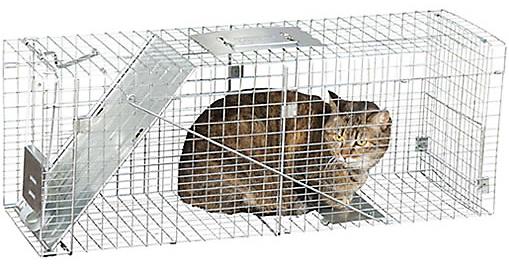 Step 2: Trapping
Step 2: Trapping
Each cat must arrive at VCAS in a metal humane live trap and covered with a towel to keep them calm. Cardboard or plastic pet carriers are not accepted. One cat per trap, please.
Step 3: Holding the Cat Overnight
Choose a place where the cat will be safe overnight while in their trap. This should be a dry, climate-controlled and well-ventilated area.
- Keep cats calm and covered with a towel.
- Water should be made available at all times. Use a bowl that cannot be tipped easily.
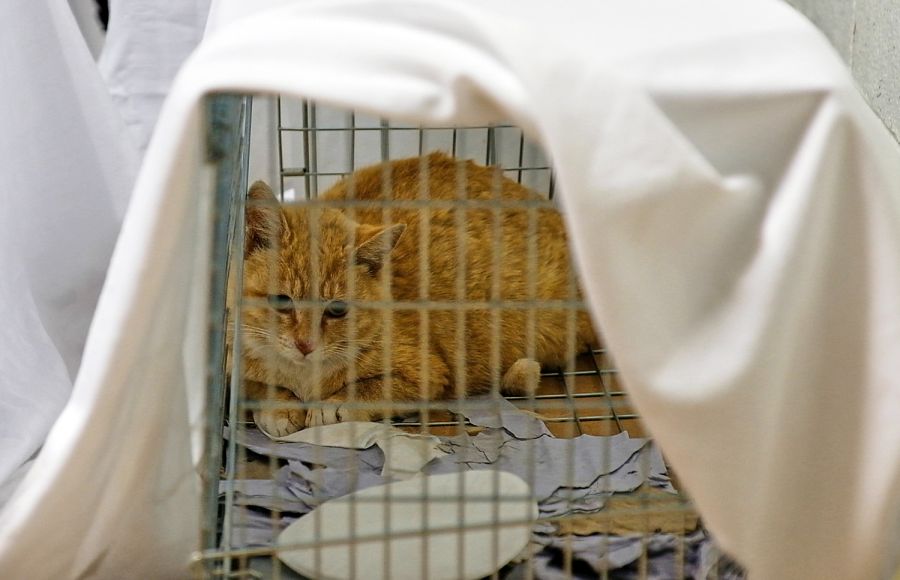
- Kittens younger than four (4) months may be fed one (1) teaspoon of wet food at 6:00am on the morning of surgery while cats older than four (4) months must fast for four (4) hours before surgery.
- Monitor the cats throughout the night and in the morning.
Step 4: Surgery Day
- Transport safely. Never transport cats in an open truck bed or in a closed, unventilated car trunk.
- Check-in at the front office of the Camarillo Animal Shelter. Be prepared to provide your full name, address, phone number, and the location where the cat was trapped.
- Owned animals are not permitted and will be rejected for surgery.
- Be available during the day to answer phone calls in the event of an emergency.
- Please note there is always a risk involved when an animal undergoes anesthesia. Caretakers are required to sign a release which hold Ventura County Animal Services, its staff, and its facilities harmless should a cat experience complications or death due to surgery. Any cat deemed to have a serious, untreatable medical condition that would make it inhumane to release back to their colony, may be humanely euthanized at the discretion of the veterinarian on duty.
Post-Surgery Instructions
- Return to the Camarillo Shelter and proceed directly to the SPAY/NEUTER PICK-UP door at the Veterinary Hospital.
- A staff member will inform you of any special instructions before you leave the facility with the cat. VCAS will not be responsible for complications arising from the use of medications obtained elsewhere.
- Anesthesia lowers a cat’s body temperature. Ensure cats are not too hot or too cold. Elevate traps with wood blocks and place newspaper on the ground to catch falling waste. Keep cats safe and calm while recovering at home.
- Monitor cats after surgery. Check on them throughout the night and before release. Check the surgical site, if safe, and watch for steady breathing. In the rare occurrence of an adverse reaction, please call (805) 388-4341.
- Wait until cats are fully awake before offering food or water. Open the trap door just enough to slide in a tuna-sized can of food as well as a water dish. Wet food is preferable.
- Sutures are absorbable and do not need to be removed.
- Lethargy (inactivity) and unsteadiness are normal during recovery.
- The following, however, are not normal behaviors: Vomiting, continued bleeding/discharge from the surgery site, and shivering the next morning. If any abnormal symptoms occur the morning after surgery, do not release the cat and call (805) 388-4341, immediately.
- Releasing cats the morning after surgery. Keeping cats longer than one (1) night can result in unnecessary stress. Lactating females should be released the night of surgery so they can return and nurse their kittens as soon as possible. A staff member will inform you if your cat is lactating. Always release cats in the area where they were trapped. To release the cat, point the front of the trap away from you so it opens to an area as free from obstructions as possible (i.e. not facing a busy street.)
CAT TRAP LOAN PROGRAM
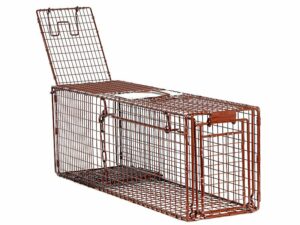 Ventura County Animal Services (VCAS) has created a Cat Trap Loan Program to provide humane traps to experienced trappers who are performing TNR services. The goal of TNR (Trap Neuter Return) is to humanely decrease the population of Community Cats who roam our streets by trapping them in a humane trap, transporting them to a veterinary facility for spay or neuter surgery, then releasing them back to the area from which they were trapped if the area is safe to do so.
If you would like to become a VCAS-approved trapper and obtain a trap from our department, please watch the instructional video below then come to the Camarillo Animal Shelter to complete the necessary paperwork. When you arrive, you will be given a short written exam to ensure you have watched and understand the information in the video. You will then be asked to read and sign a Cat Trap Loan Agreement and provide photo identification. This only needs to be done the first time you pick-up a trap.
WARNING: Traps can be harmful or deadly if not used properly. Animals could go without food or water if traps are not checked regularly, at least every one (1) hour. Traps are not meant to be placed in areas far from your home nor are they intended to be used to trap wildlife or owned animals.
Ventura County Animal Services (VCAS) has created a Cat Trap Loan Program to provide humane traps to experienced trappers who are performing TNR services. The goal of TNR (Trap Neuter Return) is to humanely decrease the population of Community Cats who roam our streets by trapping them in a humane trap, transporting them to a veterinary facility for spay or neuter surgery, then releasing them back to the area from which they were trapped if the area is safe to do so.
If you would like to become a VCAS-approved trapper and obtain a trap from our department, please watch the instructional video below then come to the Camarillo Animal Shelter to complete the necessary paperwork. When you arrive, you will be given a short written exam to ensure you have watched and understand the information in the video. You will then be asked to read and sign a Cat Trap Loan Agreement and provide photo identification. This only needs to be done the first time you pick-up a trap.
WARNING: Traps can be harmful or deadly if not used properly. Animals could go without food or water if traps are not checked regularly, at least every one (1) hour. Traps are not meant to be placed in areas far from your home nor are they intended to be used to trap wildlife or owned animals.
PICKING UP A TRAP
No appointment is necessary. If you have already completed the necessary paperwork and are in our system as a “VCAS Approved Trapper,” you will be provided a humane trap and given a return date. A $75 refundable deposit is required for each trap loaned out. Deposits can be in the form of cash or personal check and are returned/refunded when the trap returns undamaged and fully intact. VCAS is not responsible for stolen traps. If traps are stolen or damaged beyond repair, VCAS may retain the deposit in order to purchase a replacement trap. Please do not purchase a replacement trap or make any attempts to fix broken traps.RETURNING A TRAP
No appointment necessary. Upon arrival at the Camarillo Animal Shelter, a staff member will inspect the trap for damage and general cleanliness. All traps must be returned in the same condition in which they were loaned out. Please hose/wipe down the trap with plain water only, making sure there is no visible dirt, food, hair or other foreign matter. Please do not disinfect traps. Traps are disinfected on-site at VCAS. If traps are returned in an acceptable condition, your deposit will be returned/refunded. If a trap is returned in an unacceptable condition, VCAS may retain all or part of the deposit.SETTING A TRAP:
Watching the video below to learn how to set a humane trap.TRAP NEUTER RETURN (TNR)
Do you FEED or CARE for community cats? If so, please have them spayed or neutered to help decrease the population. Spay/neuter surgical services are FREE for cats intended for TNR.
Ventura County Animal Services is proud to be a part of a coordinated countywide effort to help reduce the overpopulation of outdoors cats living in our community. TNR (Trap Neuter Return) is the process by which community/feral cats are trapped by experienced humane trappers, spayed/neutered at a participating organization listed below, microchipped, and returned to the community from which they came if the location is safe to do so. These cats can now live out their lives in the environment they were thriving in without the possibility of procreation. Altered cats also have the tendency to repel unaltered cats. The process begins with the humane trapping of feral/community cats by an experienced trapper. Trappers can then schedule an appointment to bring these cats to VCAS for spay/neuter surgery. When they arrive, cats are scanned for a microchip to determine if there is an identified owner. While under anesthesia for their spay/neuter surgery, the VCAS Veterinary Team vaccinates, microchips, flea treats, and ear-tips each cat. Ear-tipping is the process by which a small portion of the cat’s right ear is removed. This is an easy indicator that the cat is already spayed or neutered and is part of an established colony, thus does not need to be re-trapped. If the area from which the cat was trapped is unsafe for return (i.e. being too close to a busy street), the cat may enter our VCAS Working Whiskers program which allow members of the community to adopt a feral/community cat to live out their lives on their property, in open areas. An application process ensures these cats are placed in appropriate locations with owners who fully understand their responsibility to these cats. VCAS is proud to be one of four (4) participating organizations who offer spay and neuter services for community cats:SIMI VALLEY NON-PROFIT SPAY & NEUTER CLINIC
(805) 584-3823
1659 E. Los Angeles Ave.
Simi Valley, CA 93065
CAMARILLO ANIMAL SHELTER
(805) 388-4341
600 Aviation Drive
Camarillo, CA 93010
HUMANE SOCIETY OF VENTURA COUNTY
(805) 646-6505
402 Bryant St.
Ojai, CA 93023
MERCY CRUSADE
(805) 278-4433
2252 Craig Dr.
Oxnard, CA 93036
If you are part of this coordinated TNR effort in Ventura County and need to schedule a spay/neuter surgery for your trapped feral/community cat, please tap/click this blue button. If you are having difficulty scheduling this appointment, please call (805) 388-4341. Thank you.
If the button above does not work, visit https://app.acuityscheduling.com/schedule.php?owner=13142745&calendarID=3118261
DUE TO A BACKLOG OF APPLICATION, AND A LIMITED NUMBER OF ELIGIBLE CATS, WE HAVE TEMPORARILY PAUSED NEW WORKING WHISKERS APPLICATIONS. WE HOPE TO RESUME ACCEPTING APPLICATIONS IN THE NEAR FUTURE. THANK YOU FOR YOUR INTEREST IN ADOPTING A COMMUNITY CAT FOR YOUR PROPERTY!
WORKING WHISKERS PROGRAM
The VCAS Working Whiskers Program provides an alternative placement for feral/community cats who cannot be returned to the area from which they came. This program allows cats the opportunity to continue doing what they love — hunting and living outdoors in open areas such as barns, horse stables or garden sheds.
Those adopting working cats apply through a formal process to ensure they meet the requirements. Adopters must be able to provide shelter, food, and water and have the ability to trap their working cats and transport them for regular veterinary check-ups.
All Working Whiskers cats are spayed/neutered, vaccinated, microchipped and ear-tipped prior to release. Ear-tipping is an easy way to differentiate between a working cat who is a member of an established colony or another stray cat who has entered the area.
Working Whiskers Application
Thank you for your interest in our VCAS Working Whiskers program! Owning a working cat can be a very rewarding experience. These cats patrol your property freely and can help keep the rodent population in-check. However, owning a working cat is very different than owning a domestic house cat. You will not be able to handle these cats nor should you attempt to do so. All members of the household, and any visitors, should understand this fact, especially young children.
If you are interested in adopting a working cat, please complete the application below to the best of your ability, and a Ventura County Animal Services staff member will contact you when a working cat becomes available. Please only complete the application when you are ready to bring a cat home.
Applicants must provide a safe environment for three (3) weeks to allow the cat the opportunity to adapt and accept their new home. Cats are subject to availability. Please email us if you have any questions or need additional information.
Working Whiskers Application
I have carefully read the information above and have completed the application completely and to the best of my knowledge and ability. By submitting this application, I certify that the information entered is true. I understand that omission of information or failure to answer all questions honestly can result in this application being denied.
Cat Enrichment
Batting Cups
- Grab a pipe cleaner and a small dixie cup.
- Poke a hole in the middle of the dixie cup. The tip of a pen works great for making the hole as it should not be a big hole!
- Slip the pipe cleaner through the hole. Knot the end of the pipe cleaner so it does not slip through the hole.
- Wrap the longer end of the pipe cleaner against a pole or kennel bar.
- Toss a few treats into the cup. You can also attach feathers or a bell before you note to make it noisy and encourage more batting!
Cat Nip Toilet Paper Rolls
- Grab a TP roll and some fresh cat nip (or dried).
- Grab some yummy treats or a few pieces of dried kibble.
- Stuff one half of the TP roll with paper towels. Once one half is stuffed, placed treats/kibble and some of the dried cat nip in the TP roll.
- Then stuff the other half of the toilet paper roll with a paper towel to hold in the cat nip and treats/kibble.
Kitty Piñata
- Fill a paper bag with some kibble or treats.
- Scrunch up the bag or leave it partially open.
- Give to the cat to enjoy!
- Grab some yummy wet food.
- Spread the wet food through the mat.
- Give to the cat to enjoy!
- Grab a puzzle feeder.
- Place daily kibble into the feeder.
- Give to the cat to enjoy!
Scrub Brush
- Grab a small scrub brush.
- Fix it to a vertical surface.
- Let the kitty groom themselves with it.
- Grab a piece of Silvervine cat nip sticks.
- Remove the outer skin.
- Give it to kitty to play with!


